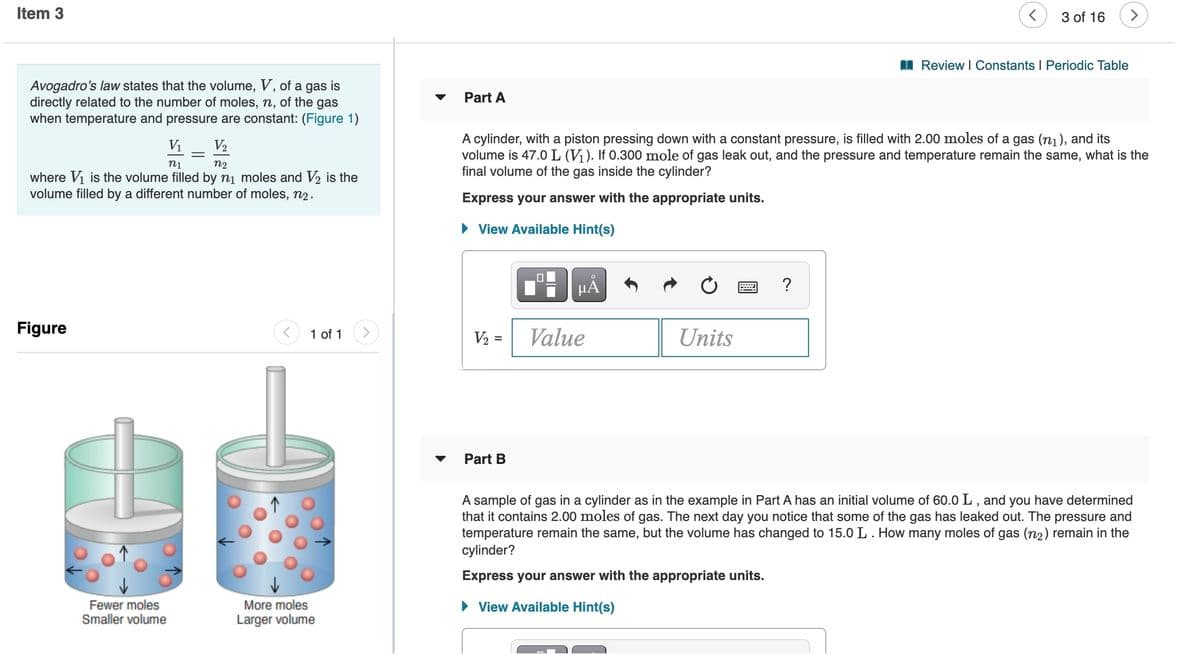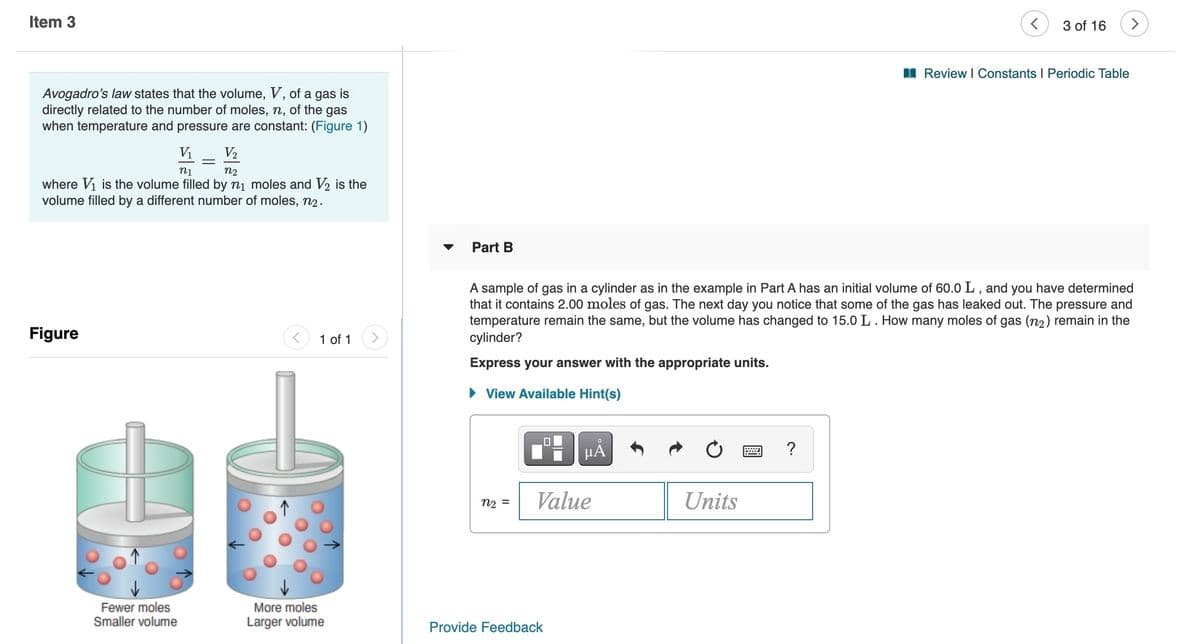Part A A cylinder, with a piston pressing down with a constant pressure, is filled with 2.00 moles of a gas (n1), and its volume is 47.0 L (V). If 0.300 mole of gas leak out, and the pressure and temperature remain the same, what is the final volume of the gas inside the cylinder? Express your answer with the appropriate units. • View Available Hint(s) HÀ ? V2 = Value Units Part B A sample of gas in a cylinder as in the example in Part A has an initial volume of 60.0 L, and you have determined that it contains 2.00 moles of gas. The next day you notice that some of the gas has leaked out. The pressure and temperature remain the same, but the volume has changed to 15.0 L. How many moles of gas (n2) remain in the cylinder? Express your answer with the appropriate units. • View Available Hint(s)
Part A A cylinder, with a piston pressing down with a constant pressure, is filled with 2.00 moles of a gas (n1), and its volume is 47.0 L (V). If 0.300 mole of gas leak out, and the pressure and temperature remain the same, what is the final volume of the gas inside the cylinder? Express your answer with the appropriate units. • View Available Hint(s) HÀ ? V2 = Value Units Part B A sample of gas in a cylinder as in the example in Part A has an initial volume of 60.0 L, and you have determined that it contains 2.00 moles of gas. The next day you notice that some of the gas has leaked out. The pressure and temperature remain the same, but the volume has changed to 15.0 L. How many moles of gas (n2) remain in the cylinder? Express your answer with the appropriate units. • View Available Hint(s)
Introduction to General, Organic and Biochemistry
11th Edition
ISBN:9781285869759
Author:Frederick A. Bettelheim, William H. Brown, Mary K. Campbell, Shawn O. Farrell, Omar Torres
Publisher:Frederick A. Bettelheim, William H. Brown, Mary K. Campbell, Shawn O. Farrell, Omar Torres
Chapter5: Gases, Liquids, And Solids
Section: Chapter Questions
Problem 5.103P
Related questions
Question
100%

Transcribed Image Text:Item 3
3 of 16
>
I Review I Constants I Periodic Table
Avogadro's law states that the volume, V, of a gas is
directly related to the number of moles, n, of the gas
when temperature and pressure are constant: (Figure 1)
Part A
A cylinder, with a piston pressing down with a constant pressure, is filled with 2.00 moles of a gas (n1), and its
volume is 47.0 L (V). If 0.300 mole of gas leak out, and the pressure and temperature remain the same, what is the
final volume of the gas inside the cylinder?
Vi
V2
n1
n2
where Vi is the volume filled by ni moles and V2 is the
volume filled by a different number of moles, n2.
Express your answer with the appropriate units.
• View Available Hint(s)
HÀ
?
Figure
1 of 1
V2 =
Value
Units
Part B
A sample of gas in a cylinder as in the example in Part A has an initial volume of 60.0 L , and you have determined
that it contains 2.00 moles of gas. The next day you notice that some of the gas has leaked out. The pressure and
temperature remain the same, but the volume has changed to 15.0 L . How many moles of gas (n2) remain in the
cylinder?
Express your answer with the appropriate units.
Fewer moles
Smaller volume
More moles
• View Available Hint(s)
Larger volume

Transcribed Image Text:Item 3
3 of 16
I Review I Constants I Periodic Table
Avogadro's law states that the volume, V, of a gas is
directly related to the number of moles, n, of the gas
when temperature and pressure are constant: (Figure 1)
Vi
V2
n1
n2
where Vi is the volume filled by ni moles and V2 is the
volume filled by a different number of moles, n2.
Part B
A sample of gas in a cylinder as in the example in Part A has an initial volume of 60.0 L , and you have determined
that it contains 2.00 moles of gas. The next day you notice that some of the gas has leaked out. The pressure and
temperature remain the same, but the volume has changed to 15.0 L. How many moles of gas (n2) remain in the
cylinder?
Figure
1 of 1
Express your answer with the appropriate units.
View Available Hint(s)
HẢ
?
Value
Units
n2 =
More moles
Fewer moles
Smaller volume
Larger volume
Provide Feedback
Expert Solution
This question has been solved!
Explore an expertly crafted, step-by-step solution for a thorough understanding of key concepts.
This is a popular solution!
Trending now
This is a popular solution!
Step by step
Solved in 2 steps with 2 images

Knowledge Booster
Learn more about
Need a deep-dive on the concept behind this application? Look no further. Learn more about this topic, chemistry and related others by exploring similar questions and additional content below.Recommended textbooks for you

Introduction to General, Organic and Biochemistry
Chemistry
ISBN:
9781285869759
Author:
Frederick A. Bettelheim, William H. Brown, Mary K. Campbell, Shawn O. Farrell, Omar Torres
Publisher:
Cengage Learning

Introductory Chemistry: A Foundation
Chemistry
ISBN:
9781337399425
Author:
Steven S. Zumdahl, Donald J. DeCoste
Publisher:
Cengage Learning

Chemistry: An Atoms First Approach
Chemistry
ISBN:
9781305079243
Author:
Steven S. Zumdahl, Susan A. Zumdahl
Publisher:
Cengage Learning

Introduction to General, Organic and Biochemistry
Chemistry
ISBN:
9781285869759
Author:
Frederick A. Bettelheim, William H. Brown, Mary K. Campbell, Shawn O. Farrell, Omar Torres
Publisher:
Cengage Learning

Introductory Chemistry: A Foundation
Chemistry
ISBN:
9781337399425
Author:
Steven S. Zumdahl, Donald J. DeCoste
Publisher:
Cengage Learning

Chemistry: An Atoms First Approach
Chemistry
ISBN:
9781305079243
Author:
Steven S. Zumdahl, Susan A. Zumdahl
Publisher:
Cengage Learning


Chemistry
Chemistry
ISBN:
9781305957404
Author:
Steven S. Zumdahl, Susan A. Zumdahl, Donald J. DeCoste
Publisher:
Cengage Learning

Chemistry: Principles and Reactions
Chemistry
ISBN:
9781305079373
Author:
William L. Masterton, Cecile N. Hurley
Publisher:
Cengage Learning